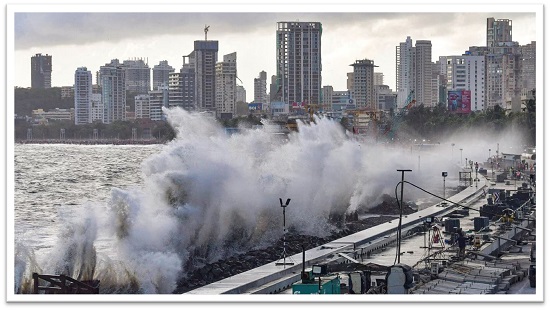
Cyclone Shakti Intensifies - Maharashtra on High Alert as Authorities Mobilize for Safety and Preparedness
As the Arabian Sea witnesses the formation of its first post-monsoon cyclonic storm, Cyclone Shakti, India braces for potential impacts along its western coastline. On Saturday morning, the India Meteorological Department (IMD) confirmed that Shakti had intensified into a severe cyclonic storm, packing wind speeds of up to 100 kmph, with gusts reaching even higher. The storm, named by Sri Lanka following the WMO/ESCAP Panel on Tropical Cyclones naming convention, is currently located approximately 420 kilometres from Dwarka, Gujarat, moving further into the Arabian Sea. While cyclones often bring challenges, the proactive steps taken by authorities reflect a strong commitment to disaster preparedness, public safety, and minimizing disruption.
The Indian government’s approach demonstrates a blend of data-driven decision-making and community-centric leadership. Advanced satellite imagery, meteorological models, and real-time weather monitoring have allowed officials to issue timely warnings. These measures ensure that citizens, especially those in vulnerable coastal and low-lying regions, are equipped with the information necessary to act promptly. The forecasted trajectory of Shakti — moving west-southwestwards before recurve east-northeastwards from Monday — indicates that authorities have critical lead time to coordinate resources and mitigate potential damage.
Cyclone’s Trajectory and Forecasted Impact
The IMD predicts that Cyclone Shakti will continue moving through the northwest and adjoining west-central Arabian Sea until Sunday. As it progresses, rough to very rough sea conditions are expected along the Gujarat-North Maharashtra coast, extending to Pakistan’s coastal areas. Forecasts suggest that wind speeds of 45-55 kmph, with gusts up to 65 kmph, will prevail along the North Maharashtra coast between October 3 and 5. Interior regions, particularly Marathwada and East Vidarbha, are likely to experience heavy to very heavy rainfall, enhancing groundwater recharge and supporting local agriculture, while also necessitating caution in low-lying urban areas.
The constructive angle of this scenario lies in the preparedness and awareness it generates. Early warnings issued by the IMD and government advisories empower communities to adopt precautionary measures, such as securing homes, safeguarding livestock, and avoiding unnecessary travel. Coastal fishermen, for instance, have been advised not to venture into the Arabian Sea until Tuesday, ensuring their safety while minimizing risks associated with severe weather conditions.
Maharashtra’s Proactive Measures and Disaster Preparedness
The Maharashtra state government has swiftly activated district-level disaster management systems to ensure a coordinated response. By instructing district administrations to implement evacuation protocols, issue public advisories, and prepare emergency resources, the state emphasizes proactive governance. Coastal districts including Mumbai, Thane, Palghar, Raigad, Ratnagiri, and Sindhudurg are on heightened alert, reflecting a targeted approach to risk mitigation.
Moreover, the focus extends beyond immediate safety. Preparedness measures are also designed to facilitate post-storm recovery. By maintaining open lines of communication, monitoring rainfall patterns, and coordinating with local authorities, the government ensures that essential services such as electricity, water supply, and healthcare remain functional. These initiatives reinforce the importance of leadership, planning, and community engagement in managing natural calamities effectively.
Cyclone Naming and Regional Collaboration
Cyclone Shakti’s nomenclature underscores regional cooperation in meteorological monitoring. Names are suggested by 13 member countries within the Bay of Bengal and Arabian Sea regions, reflecting a collaborative effort to strengthen preparedness, awareness, and timely communication. By adhering to international conventions, the IMD enhances credibility and ensures consistent dissemination of cyclone-related information across national boundaries, which is critical for both marine and coastal safety.
Community Awareness and Constructive Preparedness
While severe cyclonic storms naturally present challenges, they also offer opportunities to strengthen resilience and public awareness. Citizens in vulnerable districts are encouraged to follow government advisories, secure their homes, and avoid non-essential travel. Social media campaigns, public announcements, and mobile alerts complement traditional disaster management strategies, ensuring that communities are well-informed and capable of responding effectively. Such measures highlight how constructive engagement, timely communication, and disciplined governance can significantly reduce the impact of natural hazards.
Conclusion: Leadership and Preparedness as Key Pillars
Cyclone Shakti serves as a reminder of the critical importance of data-driven decision-making, proactive governance, and community engagement in disaster management. While the storm brings the potential for disruption, the coordinated efforts of the IMD, Maharashtra state authorities, and local communities demonstrate a model of resilience. By combining scientific foresight, timely advisories, and public participation, India exemplifies how leadership and preparedness transform potential threats into opportunities for enhanced awareness, safety, and long-term resilience.





